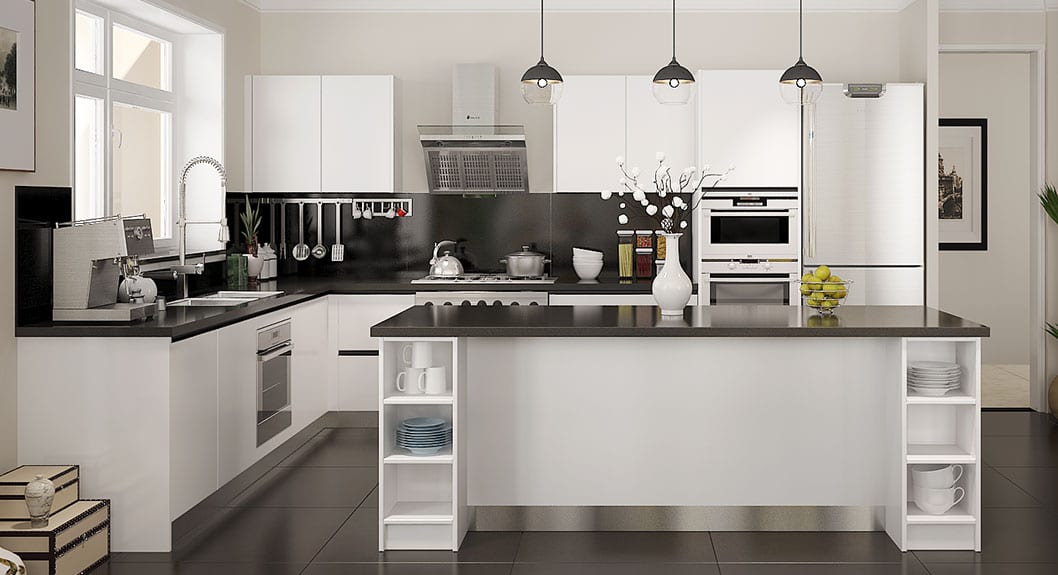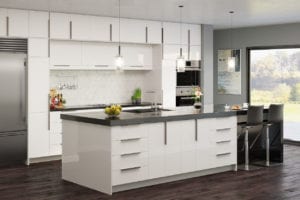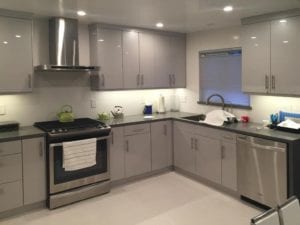European cabinet builders can use European-style kitchen cabinets to allude to a more significant degree of modular artistry. Many people in Europe own their kitchen cabinets even if they do not own the house or flat they live in. It is common to buy or rent a home that lacks both kitchen equipment and cupboards. As a result, the European cabinetry industry encourages individuality in conjunction with modular design elements that may be readily added and removed from any area.
The fact that European kitchen cabinets are widely accessible is a plus. European cabinets are unique in several aspects. These cabinets are one-of-a-kind in every way, including shape and function. If you incorporate them in your kitchen, you will have a sense of comfort and elegance due to their modern internal doors, neatness, and characteristic streamlining.

Key Facets of European-style kitchen cabinets
The following are the critical attributes of European-style kitchen cabinets:
- Plywood structure: Plywood is the most often used material for cabinet boxes. Full plywood sides and backs are used in high-quality and robust cabinets. It keeps these boxes hygienic during transport and setup. The heavyweight countertops may be effortlessly handled with an all-plywood structure. It also shields the cabinet boxes from dampness. The majority of kitchen cabinets in Europe are made of plywood. It makes them long-lasting in every way. Most kitchen cabinets are also composed of particleboard. It is a less expensive option than plywood.
- Center back panels: The installation procedure is heavily reliant on the cabinet back structure. A solid cabinet features a central-back panel. European cabinets are typically a good option since the plywood used is stable and solid. If you want a long-lasting cabinet, opt for sturdy, full-height plywood.
- Unique designs: The stately European kitchen cabinets and doors have various dramatic angles. These
 cabinets have flowing curves that add to their appeal. In general, increased kitchen cabinets are simple in design. The simple form and feel of these kitchen cabinets appeal to people of all ages and with a wide range of tastes. The majority of these cabinets have smooth surfaces, smooth doors, and minimum hardware.
cabinets have flowing curves that add to their appeal. In general, increased kitchen cabinets are simple in design. The simple form and feel of these kitchen cabinets appeal to people of all ages and with a wide range of tastes. The majority of these cabinets have smooth surfaces, smooth doors, and minimum hardware. - Natural components incorporation: This is another essential feature of a European kitchen cabinet. While traditional kitchen design used natural elements as well, European kitchens took it a step further. Molded plastics, laminate, and ceramics are among the most prevalent materials used in European cabinets. The most excellent European kitchen designs use natural elements such as granite worktops, attractive wood furnishings, and a streamlined flooring structure.
- Utilization of accessories and other tiny components: Whether large or little, accessories play an essential role in European kitchen design. These kitchens have a modern and appealing appearance that draws the attention of the general public. You might also choose to have frosted glass installed in place of cabinet doors. Cooking appliances like coffeemakers, mixers, and blenders are essential in European kitchen design. These accessories come in a variety of styles that will enhance the appearance of your kitchen.
- Smooth flooring patterns: Smooth flooring components make European kitchens even more appealing. These kitchen flooring and tile work are consistent with the entire style. Local styles peculiar to a region or nation are adopted in smaller European kitchens. For example, terracotta and porcelain tiled kitchens are popular in Italy, although natural colors and tones are becoming more popular in French kitchens.
- Appealing furniture: European kitchens are often smaller than Asian versions. These kitchens’ furniture is not only beautiful but also functional. Blue, yellow, orange, and red dominate the table and chair sets utilized in these kitchens.
- Enhanced effectiveness and simplicity of use: European-style kitchen cabinets deliver maximum utility via effective storage systems that maximize capacity and organization. These cabinets are designed to prioritize the demands of the user while prioritizing efficiency. There are no odd kitchen cabinet corners that are unreachable, and opening cupboard doors is a breeze. Its design also includes wire baskets and other connected elements, reducing the need to search around for what you’re looking for.
European style kitchen cabinet finishes
European-style kitchen cabinets generally employ modern alternative materials to produce a seamless design and super sleek aesthetic, rather than allowing the inherent beauty of genuine wood to show out. As previously stated, material finishes are frequently synthetic and highly treated. The finish is a hallmark aspect of European design kitchen cabinets. This positively reflecting surface is created via the application of several finishing processes that need a labor-intensive procedure. Wood is another popular finish, but rather than utilizing actual hardwoods in their pure, intricate designs, and cabinet materials are frequently coated with finishes that mimic and approximate the beauty of actual wood, like veneers or laminates. Various materials may be utilized to obtain a highly polished, glossy finish for European design kitchen cabinets. Here are a few examples of popular high gloss treatments used in European kitchen cabinet designs:
- Thermofoil: A standard finish for European-style kitchen cabinets and adaptable kitchen cabinet systems is thermofoil. Foils, also known as Thermofoil, are synthetic materials made mostly of plastic covering and flexible vinyl. Thermofoils are commonly heated and adhered to a cabinet substance such as medium-density or engineered wood. This results in a highly resilient and long-wearing finish that is susceptible to flaking on kitchen cabinets.
- Laminates: These are a low-cost alternative to attaining a high-gloss finish for kitchen cabinets. Because of its vast availability and numerous color possibilities, this is commonly used for European design kitchen cabinets,
 allowing for maximum customization. Laminates are the most popular modern finishing material, and they are more widely employed in current styles than conventional cabinet design. Some people refer to it as Formica, a well-known brand of laminates. This thin, lightweight material was formerly thought to be brittle and unstable. Still, new production procedures increased the quality of laminates and gave them a better, more robust, and more enduring nature.
allowing for maximum customization. Laminates are the most popular modern finishing material, and they are more widely employed in current styles than conventional cabinet design. Some people refer to it as Formica, a well-known brand of laminates. This thin, lightweight material was formerly thought to be brittle and unstable. Still, new production procedures increased the quality of laminates and gave them a better, more robust, and more enduring nature. - Lacquer is a sort of protective finishing compound composed of shellac that comes in various hues ranging from clear to colored wood. However, lacquer merely serves as a protective varnish or a glossy topcoat rather than adding color to kitchen cabinets. The kitchen cabinet materials must still be painted or coated. If you want to keep the original aesthetic of your kitchen cabinets but add a gloss, you may use lacquering. It forms a rugged and robust surface when lacquer dries, allowing European-style kitchen cabinets to survive for years without damage or shattering.
Why Consider European-style Kitchen Cabinets
Sturdiness: Because the full frameless cabinet is built of particleboard or solid plywood, it’s durable.
Ease of access: Because they are not reinforced, most cabinet frames made of hardwood take up many rooms.
Increased Inner Space: European Kitchen Cabinets feature more storage area since the box acts as the structure and requires fewer supports and bracing.
Elegant: European Kitchen Cabinets are an excellent choice for a kitchen design since they are incredibly unique and have a smooth flowing design.

